Table of contents:
What is Automotive Augmented Reality?
3 Types of AR Applications Disrupting the Automotive Industry
The automotive industry has had a continuous history of innovation since its beginnings in the 19th century. Steam-powered road vehicles gave way to automobiles with gasoline engines, which have evolved into AI-powered self-driving cars, electric cars full of modern applications, and futuristic concepts yet to be developed by car manufacturing industry.
A century ago, people had no clue how drastically the automotive industry would change thanks to technological progress and outstanding design. Is it possible we’re equally unaware today of what’s still to come? Let’s figure it out with us – leading AR/VR development company.
What is Automotive Augmented Reality?
3 Types of AR Applications Disrupting the Automotive Industry
The implementation of Augmented Reality is a disruptive force in any industry. In automotive, the technology revolutionizing traditional approaches to car prototyping, manufacturing, and advertising. It even helps to effectively plan production plants. Maybe cars of the future will differ from the current ones as much as electric cars differ from steam-powered automobiles, and all of this thanks to AR.
Let’s start with the basics.
How does Augmented Reality work?
It’s a technology that combines reality and digital content by overlaying images, 3D models, buttons, audio, and other content on a real-world image.
To experience AR, users need to use particular devices:
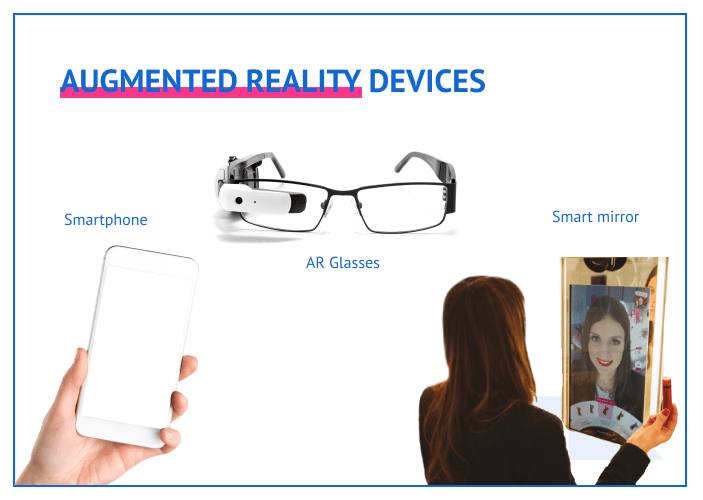
Automotive businesses use AR intensively for added value in nearly every aspect of their processes, from car prototyping to car repair user manuals.
Technological advancement in connectivity is driving the development of AR in the automotive sector. From 2017 to 2025, the market for Augmented Reality and VR automotive solutions is expected to grow at a CAGR of 175% and will reach around $673 billion.
But what is so attractive about AR in the automotive market?
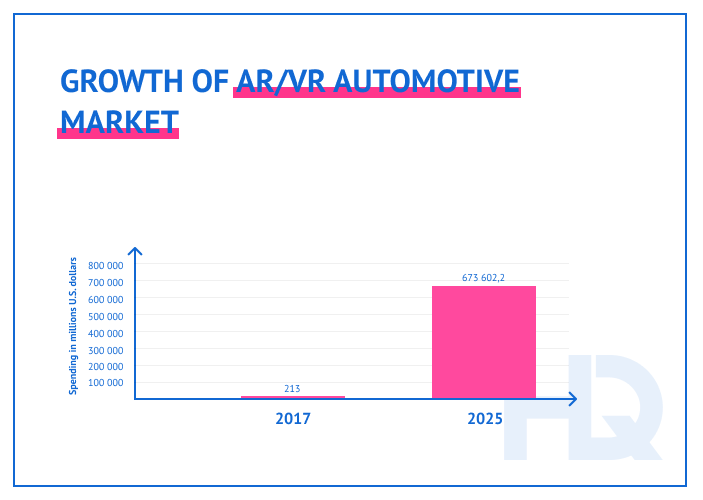
Let’s take a look at the benefits AR services bring to the automotive field.
To reiterate, AR is used for multiple purposes in the industry, covering processes ranging from new car model prototyping to providing drivers with visual manuals so they can deal with uncomplicated maintenance and repairs. Besides this wide range of applications, AR services provide many benefits:
AR services greatly enhance automotive engineering. With AR, it is possible to produce new models or alter the design of a car without needing to manufacture a real product to prove it can be done. Everything can be designed with the help of AR visualization.
For example, engineers at BMW use an AR automotive solution called Augmented Reality Engineering Space to speed up prototyping by as much as 12 months. Using AR, engineers verify assembly processes at early stages and then adjust them as needed for series production. AR-integrated training apps are used to teach particular skills important for effective prototyping techniques.
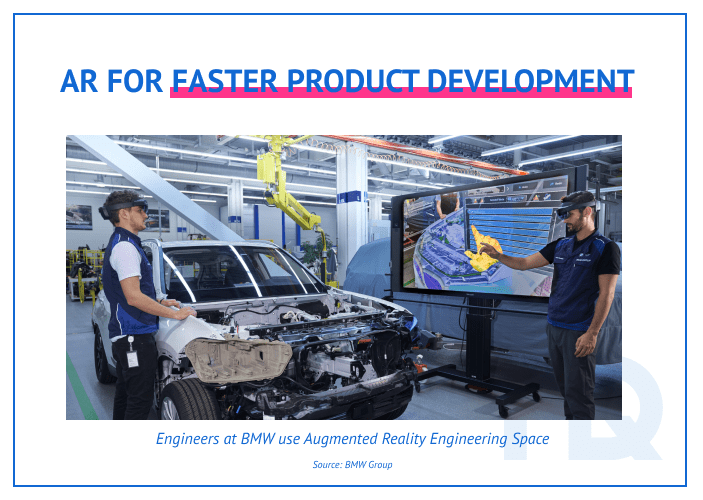
It is crucial for any automotive business to plan their production capacities correctly, and again AR is extremely useful.
With the help of AR services, designs for new equipment and buildings can be overlaid on the space of existing production halls. Production processes, material flows, and even logistics can be simulated and optimized virtually and remotely via AR-assisted apps. Audi is already reaping the benefits of this approach.
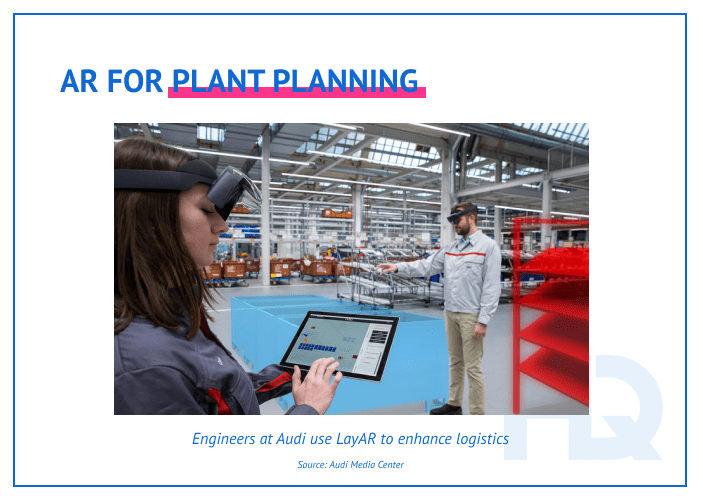
The automotive industry is well-known for the complexity of its production processes. Car manufacturing involves assembling thousands of components with excellent accuracy and in a strictly designed sequence. Sounds complicated, right?
We develop AR automotive solutions for businesses
HQSoftware has a team of skilled professionals ready to tackle the project. Let’s talk!
Anna Halias
Business Development Manager,
HQSoftware
This complexity produces a high-quality end-product, something that’s non-negotiable in today’s competitive environment. But how can companies improve efficiency while maintaining quality in an increasingly complex environment?
Once again, AR automotive solutions come to the rescue. Augmented Reality in car manufacturing can enhance production workers’ understanding of the assembly instruction documents they are to follow. AR allows for providing visual instructions overlaid on a real-world image: the workers can use AR-glasses to see instructions that become their “third hand.” It decreases human errors and speeds up the assembly.
BMW uses such AR services to build visual bolt-welding manuals.
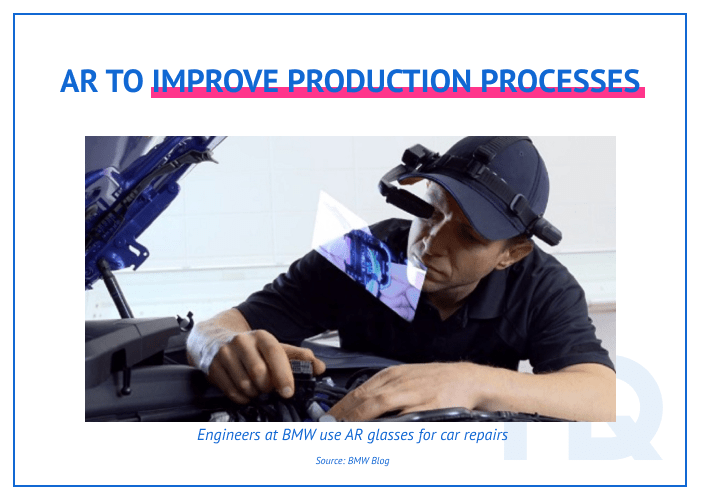
With AR, automotive companies can build advanced user manuals for customers that will thoroughly describe what exactly to do in various situations. Augmented Reality mobile applications offer contextual and visual guidance, unlike simple text manuals.
With such apps, users can figure out what’s on the car’s dashboard on the go, and even carry out simple maintenance by themselves, without the need to visit a mechanic. Changing your oil, for example, becomes easier than ever.
But mechanics can make use of such apps too. At Mercedes-Benz, technicians use Microsoft HoloLens 2 to fix cars. The workers wear glasses and receive remote assistance and visual hints provided by specialists from all over the world, including engineers from the headquarters in Germany.
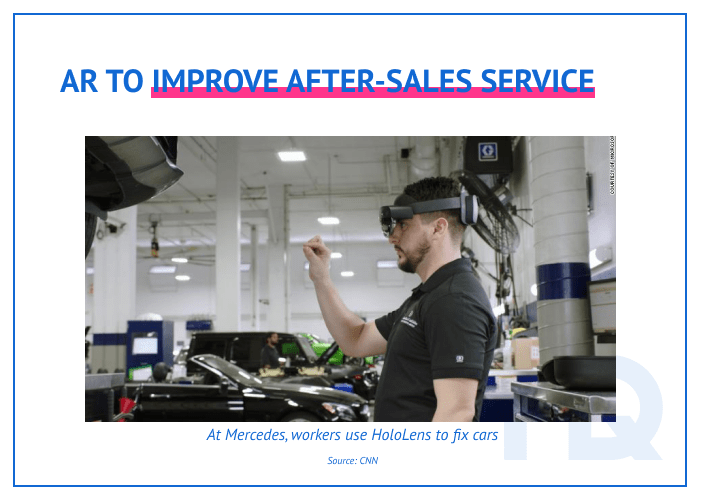
Augmented Reality application development can transport the “car experience” much more directly to the target audience than traditional advertising. Just imagine: you are holding a familiar printed brochure with a QR-code or another marker on it; you scan it with your smartphone and enjoy an AR experience — a 3D interactive model of your desired car, in the palm of your hand.
There is space for experiments, too. Developers can add various features to the app, to help customers imagine their dream car with ease, e.g. by changing the color or equipment options. See how Lexus did it:
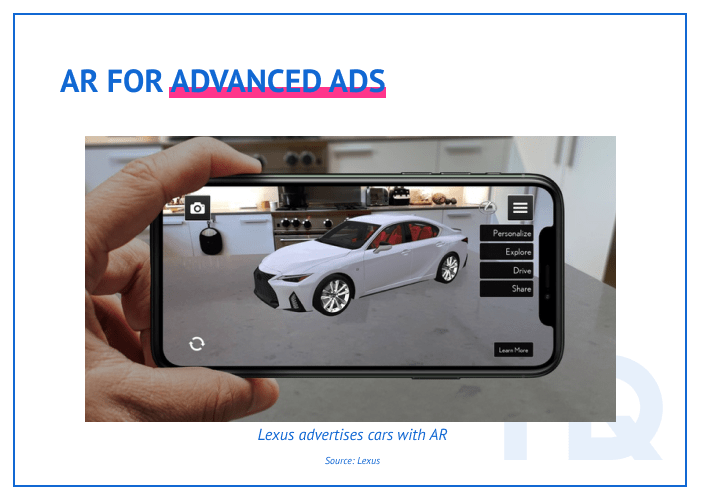
There are tons of applications for AR in the automotive industry, but if we had to pick just the top 3, we’d choose the following.
Here are three AR services currently influencing the automotive industry the most, thanks to a plethora of benefits.
AR has revolutionized the process of designing and manufacturing of a vehicle. A vehicle’s success with customers depends on its design, both interior and exterior features.
Traditionally, this process involves an engineer designing all vehicle components manually using a computer. Then, components are produced to build a real-life prototype and see whether it is viable.
The process is extremely time-consuming and expensive and demands significant commitment to test a large number of components and prototypes to select the best ones.
To make this process more cost-effective, automotive businesses turn to AR services. AR automotive solutions allow for testing and fine-tuning new cars before they enter the market and offer tools that assist in the whole cycle, from concept design and prototyping to manufacturing.
Many automotive giants and smaller businesses use Augmented Reality for car designing and prototyping, often partnering with Microsoft. See how Ford uses HoloLens for car prototyping:
Sales techniques in the automotive industry remained pretty stagnant for years, but AR can reinvigorate the process for both customers and businesses, and has helped in the invention of whole new sales patterns.
The majority of online transactions are already happening on mobile devices, so why shouldn’t automotive companies use them as a platform for advanced marketing and sales using AR?
How do modern businesses use AR to increase their revenues and outperform their industry competitors?

Augmented Reality in manufacturing is being used to create digital showrooms, where customers can virtually check out several automotive models using just their smartphone and an AR experience — no need to visit a real showroom.
AR allows for changing the specifications of a selected car, changing combinations of colors and designs in real-time, and seeing a lifelike interactive model of a car in AR.
There is even a business that is not an automotive company but which creates numerous models of cars of various brands for customers to see and test in 3D, via AR. Want to see how a new Porsche or luxury BMW will look on your driveway? With this app, you can.
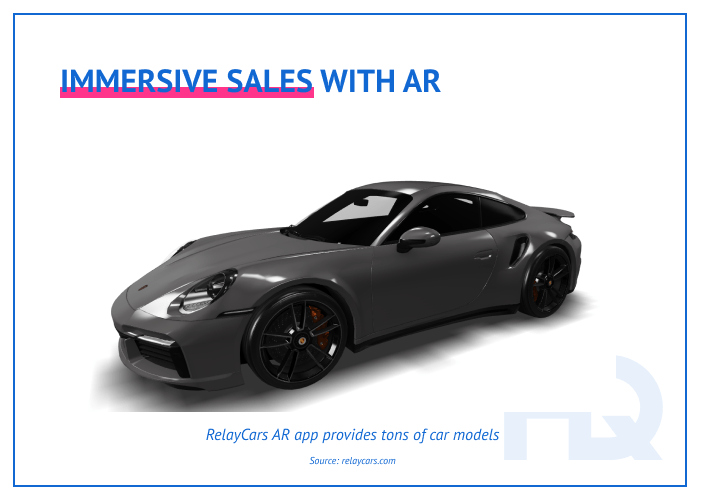
In addition, automotive brands have their own virtual car showrooms. For example, Volkswagen showcases its new ID.4 in AR for all interested buyers.
A great many beginners fail their first attempt at passing the driver’s test. It’s frustrating and often wastes money and time when the new driver just wants to get on the road safely and quickly. AR can help.
AR-assisted apps can greatly enhance the driving experience for both new and experienced drivers. There are AR concepts of heads-up displays that transform a car windscreen into a computer screen, providing augmented travel information: navigation indications, weather, traffic data, and so on.
For example, LG Electronics is developing an AR solution for vehicles to help keep everyone safer on the road. The solution provides drivers with all-important data to judge driving conditions wisely: current speed, relative position to other cars as well as pedestrians, the fastest route to the selected destination, and so on. All data is displayed on a heads-up display so that drivers don’t have to take their eyes off the road.
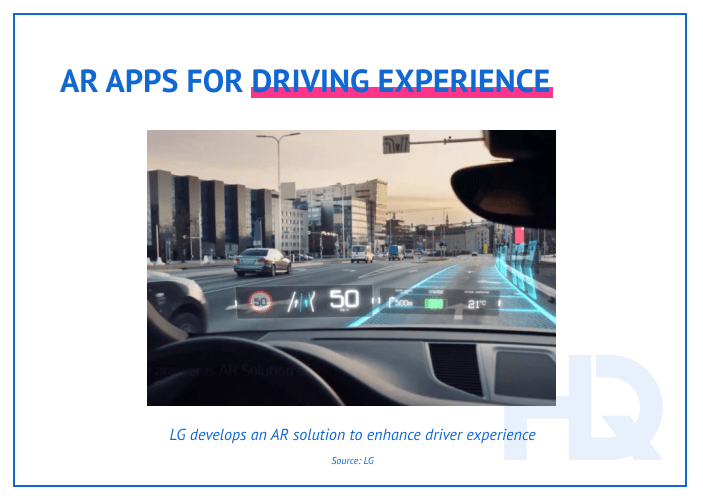
Other working concepts include enhanced car windows. As Toyota has shown, such windows can allow passengers to select real objects through the window, zoom into them, and get additional information.
Now that we have seen some ways to use AR in the automotive industry, let’s look at prospects for the future.
As mentioned earlier, the market for Augmented Reality in automotive is growing at a tremendous pace and is expected to reach $673 billion by 2025. There are technologies and concepts that are attracting both industry giants and investors on a mission to build solutions of the future.
Let’s take a look at some of the most interesting ones.
AR and other technologies, such as Artificial Intelligence, will take the driver to the passenger’s seat. The in-car experience will drastically change when the driver no longer needs to actually drive because a precisely configured and educated AI solution controls the car; a solo occupant can simply admire the view and enjoy rich in-cabin entertainment and other information brought via AR.
In newer car designs and concepts, we will likely see more heads-up displays (HUDs); that is, technology that projects data on the car’s windshield and engages the driver or passenger in an AR experience. HUDs, originally designed for the military, for instance in aircraft to display important data, will find their way to consumers in future cars.
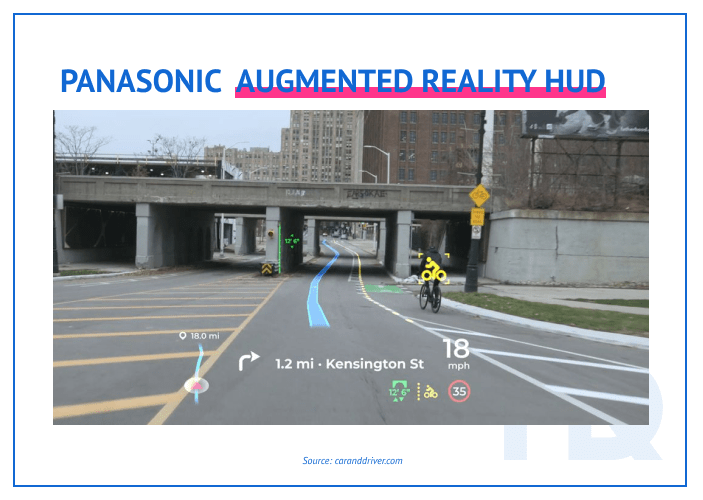
For example, Panasonic’s AI-powered HUD may be in cars by 2024. It is trained to spot pedestrians, highlight crosswalks, and help to prevent potential collisions.
Another impressive solution in this field is WayRay’s Deep Reality Display® — an AR solution for cars that turns HUDs into a combined solution with entertaining content, an Advanced Driver Assistance System, and navigation tips. This AR automotive solution lets drivers and passengers interact with the ride as if they were some kind of game character, while both entertaining the passenger and effectively keeping the driver’s eyes on the road.

In newer car designs, we’ll likely see more heads-up displays that essentially share the same information your dashboard currently does, but directly on your windshield.
The more the world goes remote, the more online shopping prevails over offline. But what about car shopping?
According to at least one study, consumers during the pandemic have spent less time looking for a car, and doing so online. In 2019, consumers spent 9 hours and 29 minutes shopping for a car; in 2020 this number decreased to 7 hours and 14 minutes.
Customers agreed that being able to shop for a car without the need to visit an actual dealership is the most important benefit of virtual car shopping. So how can AR in the automotive industry enhance this shopping experience so that customers enjoy virtual shopping even more?
In the future, Augmented Reality mobile applications have the potential to fully replace offline shopping. In terms of the automotive industry, AR has all the required tools to be able to showcase cars for customers in detail, from colors and exterior features to every part of the interface and interior. AR solutions allow the customer to zoom in on and rotate a car, place it virtually in their driveway, peer at the inner workings of the car as though with X-ray vision, and dive deeper into engineering details.
For example,Skoda’s AR app offers all the aforementioned features and even allows users to “sit” inside a life-size virtual model of a car placed right before the user on the ground.
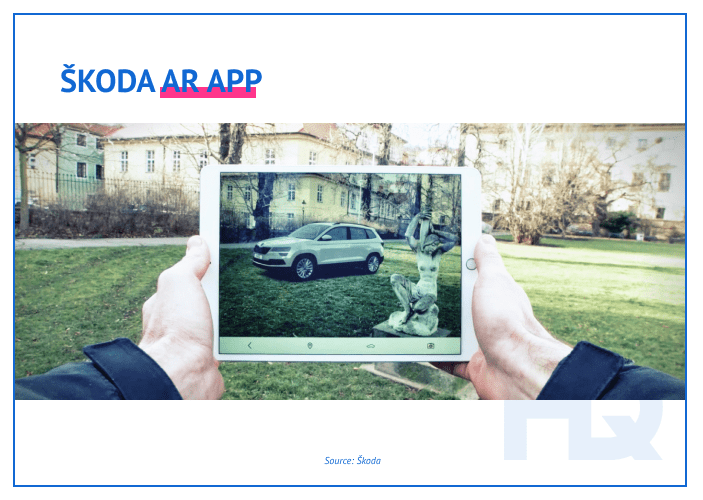
As you can see, AR automotive apps have a lot of advantages in the automotive field, for everything from self-driving cars to virtual showrooms. More and more AR features are being incorporated into future car concepts, and it’s just a matter of time before we see all these concepts becoming real.
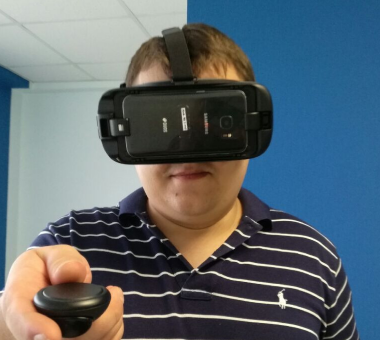
AR/VR Expert
A developer with extensive expertise in AR/VR, very ingrained into the topic of Mixed Reality development. Shares his knowledge and the results of many years of work.
We are open to seeing your business needs and determining the best solution. Complete this form, and receive a free personalized proposal from your dedicated manager.

Sergei Vardomatski
Founder